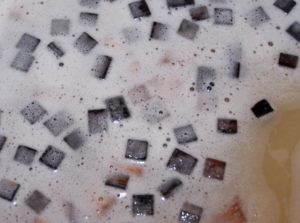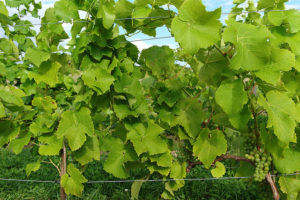
Photo by Agne27 [GFDL (http://www.gnu.org/copyleft/fdl.html) or CC-BY-SA-3.0 (http://creativecommons.org/licenses/by-sa/3.0/)], via Wikimedia Commons
Another way to impart oak flavors into wine, which isn’t as common but has been studied a bit in the literature, is oak extract application on grapes or grape vines. While studies have shown this sort of treatment may produce similar aromatic and sensory characteristics in the finished wine as a wood-aged treatment would, it’s likely just a way to get a “flavor now!” response and not a functional aging ability.
Of course, there are many other oak alternatives utilized in commercial especially home winemaking, but I won’t go into that now.
One new study, currently available online and to be published in print in October 2018 in the journal Food Chemistry, aimed to add one more potential oak alternative to the winemakers’ arsenal that I wasn’t expecting: grapevine shoots. Partially a response to growing demand for oak barrel alternatives, and partially a response to the amount of physical waste generated after the grape harvest, a team of Spanish researchers aimed to evaluate the use of grapevine shoot “chips” (toasted) as an alternative to oak chips in winemaking.
Brief Methods
Airén and Tempranillo shoots were pruned about 90 days after grape harvest in Castilla-La Mancha, Spain. After a period in dark storage, shoots were cut into 2-7cm length samples and subjected to a medium toast treatment. Shoot “chips” were toasted at either 160oC or

Photo courtesy Flickr user Sigfrid Lundberg
180oC for 45, 60, or 75 minutes.
Toasted oak chips were used as a control/comparison.
Oak and shoot chips underwent chemical analysis to test: volatiles, low molecular weight phenolic compounds, tannins, and condensed tannins (proanthocyanidin oligomers).
Selected Results
Oak Chips versus Shoot Chips
- Oak chip aroma was characterized by furanic groups, benzenoid groups, whiskey lactones, and terpenes.
- Furanic compounds were higher in Airén shoot chip samples toasted at 180oC than all other chip samples.
- Total benzenoid content of shoot chips occurred at the 180oC for 45 and 75-minute toasting treatments.
- Guaiacol levels were higher in shoot chips than oak chips.
- Acetovanillone levels were higher in shoot chips than oak chips.
- Whiskey lactones were found in Airén shoot chips, but not high enough levels to be quantified.
- Terpene levels in oak chips were statistically similar to Tempranillo shoot chips but were found to be significantly higher in Airén shoot chips.
- Highest terpene levels in Airén shoot chips were attained at the 160oC toasting treatment.
- Terpene levels in Airén shoot chips were higher than benzenoid group compounds (opposite of what is seen in oak chips).
- C13 norisoprenoids and C6 compounds were not found in oak chips but were found in both types of shoot chips.
- Total tannin levels were twice as high in oak chips than shoot chips.
- Oak chip tannin fraction was represented primarily by ellagitannins, while the shoot chip tannin fraction was represented by oligomeric procyanidins.
- Tannin levels were significantly higher in Airén shoot chips than Tempranillo shoot chips.
- The longer the toasting time (and higher temperature), the lower the tannin levels.
- Acid content of oak chips was 6 times higher than shoot chips.
- Flavanol levels were lower in oak chips than shoot chips.
- Stilbenes were only found in shoot chips.
- Iferaldehyde and sinapaldehyde levels were the same for oak chips and both shoot chips.
- In general, a comparison of the chemical contribution of oak chips versus shoot chips showed marked differences.
Airén Chips versus Tempranillo Chips
- Total volatile content was higher for Airén chips than Tempranillo chips.
- Terpenes and C13 norisoprenoids showed the greatest differences between the two types of shoot chips.
- Farnesol and geranyl acetone showed the biggest differences, with their concentrations 3 and 2 times higher, respectively, in Airén shoot chips.
- Furanics, benzenoids, C6 alcohols, and some other “wood-derived” compounds were higher in Airén shoot chips than Tempranillo shoot chips.
- 4-vinylguaiacol and vanillin made up 80% of the benzenoids found in the shoot chips, with their concentrations higher in Airén than Tempranillo.
- Acetovanillone levels in Airén shoot chips were twice as high as the levels found in Tempranillo.
- 1-hexanol was the only C6 compound found and was higher in Airén shoot chips than Tempranillo shoot chips.
- Syringol levels were 4 times higher in Airén shoot chips than Tempranillo shoot chips.
- Mean polymerization degree was higher in Airén (2.29) than Tempranillo (2.04).
- Airén shoot chips would likely be more astringent and bitter than Tempranillo shoot chips.
- High levels of prodelphinidins (antioxidants) were found in both shoot chips.
- Low molecular weight phenolic compound levels were higher in Airén shoot chips than Tempranillo.
- (+)-catechin and (-)-epicatechin levels were the same between the two shoot chips.
- Ellagic acid levels were higher in Airén shoot chips than Tempranillo.
- Gallic acid levels were similar between the two shoot chip types.
- Protocatechuic acid was only found in Airén shoot chips.
- Ferulic acid was higher in Tempranillo shoot chips compared to Airén.
- Trans-caffeic acid was not found in shoot chips, but the ester, trans-caftaric acid, was found in Tempranillo shoot chips.
- Trans-p-coumaric acid and trans-p-coutaric acid levels were higher in Tempranillo shoot chips than Airén.
- Stilbene levels were similar between the two shoot chip types.
- Trans–resveratrol levels were higher in Airén shoot chips than Tempranillo.
- Piceid-trans-resveratrol and trans–ε-viniferin (trans-resveratrol precursors) were higher in Tempranillo shoot chips than Airén.
- Iferaldehyde and sinapaldehyde levels were higher in Tempranillo shoot chips than Airén.
Conclusions

Photo by By Mark Smith [CC BY 2.0 (https://creativecommons.org/licenses/by/2.0)], via Wikimedia Commons
Of course, this study just provided the chemical analysis, with no sensory analysis to complement the data. I would have loved to see what the wines made from vine shoot chips would be compared to oak chips, and if the aging potential is the same or not. It was also very interesting to see how different the two cultivars were in terms of their chemical composition. It should come as no surprise, I suppose, since we already know the chemical composition of grapes is very different between cultivars, but it is still interesting nonetheless.
Finding ways to utilize the waste resulting from post-harvest pruning is a great idea from an environmental perspective and incorporating that into the winemaking process itself if an interesting idea that I would like to see more research on. If grapevine shoots chips are to be a viable alternative to oak chips in winemaking, we need to see more studies incorporating sensory analyses as well as many more cultivars for winemakers to choose what is best in their enological arsenal.
Source:
